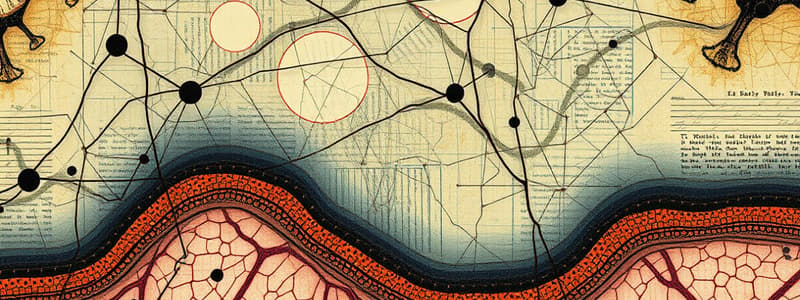Podcast
Questions and Answers
What is one function of epithelial tissue?
What is one function of epithelial tissue?
- Provide strength to other tissues
- Facilitate contraction and movement
- Transmit nerve impulses
- Cover external surfaces of the body (correct)
Which characteristic is NOT associated with epithelial tissue?
Which characteristic is NOT associated with epithelial tissue?
- Avascularity
- Presence of sensory nerve endings
- Rapid regeneration
- High levels of extracellular substance (correct)
What two components make up the basement membrane?
What two components make up the basement membrane?
- Collagen and elastin
- Epithelial cells and connective tissue
- Basal lamina and connective tissue
- Basal lamina and reticular lamina (correct)
Which tissue is primarily responsible for contraction and movement?
Which tissue is primarily responsible for contraction and movement?
Which type of epithelium lines body cavities and forms glands?
Which type of epithelium lines body cavities and forms glands?
What is NOT a function of the basal laminae?
What is NOT a function of the basal laminae?
Which layer of the embryo gives rise to the lining of the respiratory tract?
Which layer of the embryo gives rise to the lining of the respiratory tract?
Which type of epithelial tissue consists of multiple layers of cells?
Which type of epithelial tissue consists of multiple layers of cells?
What characteristic distinguishes pseudostratified epithelium from simple epithelium?
What characteristic distinguishes pseudostratified epithelium from simple epithelium?
Which type of epithelial tissue typically enhances absorptive processes in organs like the intestine?
Which type of epithelial tissue typically enhances absorptive processes in organs like the intestine?
Flashcards are hidden until you start studying
Study Notes
Tissues Overview
- Tissues are organized groups of cells performing specific functions.
- Four basic tissue types: Epithelial, Connective, Muscular, Nervous.
- Understanding normal tissues aids in identifying abnormal conditions.
Epithelial Tissue
- Composed of closely packed cells forming sheets.
- Functions include:
- Covering body surfaces (skin).
- Lining body cavities (mesothelium).
- Forming glands related to secretion.
- Main characteristics:
- Avascular (without blood vessels).
- Strong cellular junctions for cell attachment.
- Lies on a basement membrane with minimal extracellular substance.
- Contains sensory nerve endings and exhibits rapid regeneration.
Functions of Epithelium
- Protection: Skin, vagina, anal canal, oral cavity.
- Absorption: Intestinal lining.
- Secretion: Glandular epithelial cells.
- Sensation: Specialized neuroepithelium.
- Excretion: Sweat glands.
- Transportation: Cilia in oviducts for movement of materials.
- Reproduction: Germinal epithelium for sperm and egg production.
- Lubrication: Sebaceous glands.
- Prevention of blood clotting: Endothelium in blood vessels and heart.
Basement Membrane
- Sheet-like structure between epithelium and connective tissue (CT).
- Composed of:
- Basal Lamina (derived from epithelium).
- Reticular Lamina (derived from connective tissue).
- Functions include:
- Structural support and attachment for epithelium.
- Filtration in renal glomerulus.
- Regulation of epithelial repair and regeneration.
- Limiting invasiveness of epithelial tissues.
Epithelial Derivatives from Germ Layers
- Ectoderm: Skin, epithelium in mouth, nose, anus.
- Mesoderm: Endothelial lining of blood vessels, mesothelial lining of body cavities.
- Endoderm: Lining of respiratory and digestive tracts, associated glands (liver, pancreas).
Types of Epithelial Tissues
-
Classification based on cell layers:
- Simple: Single layer of cells.
- Pseudostratified: Appears to have multiple layers due to varying cell heights.
- Stratified: Multiple layers of cells.
-
Classification based on cell shape:
- Squamous: Flattened cells resembling fish scales.
- Cuboidal: Cube-shaped cells with spherical nuclei.
- Columnar: Tall, column-like cells with elongated nuclei.
Simple Epithelia
- Found in absorptive surfaces (e.g., intestines) and secretory surfaces (e.g., glands).
- Single layer of cells enhances absorption and secretion efficiency.
Studying That Suits You
Use AI to generate personalized quizzes and flashcards to suit your learning preferences.




